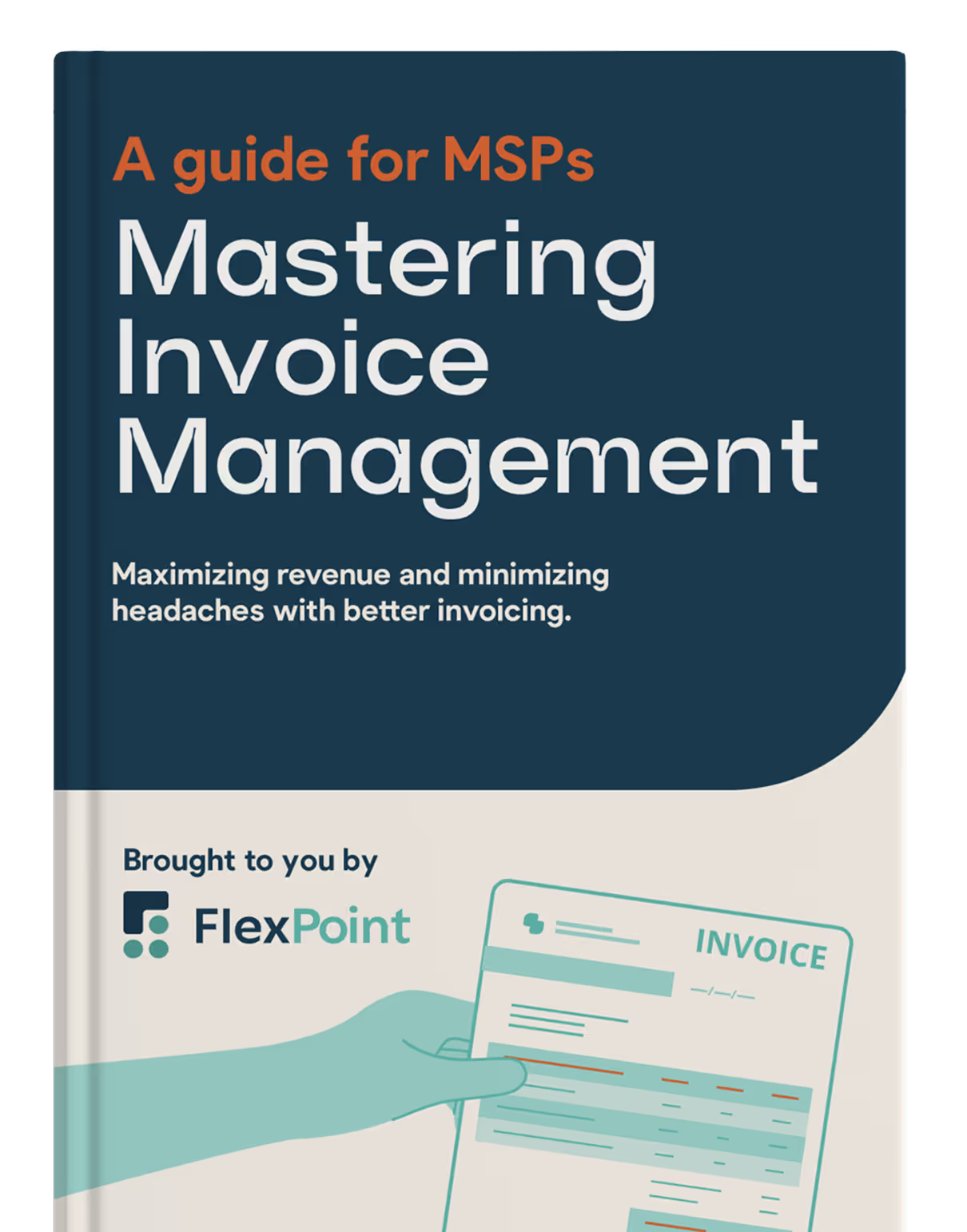Strategic Pricing Models for MSP Billing Success
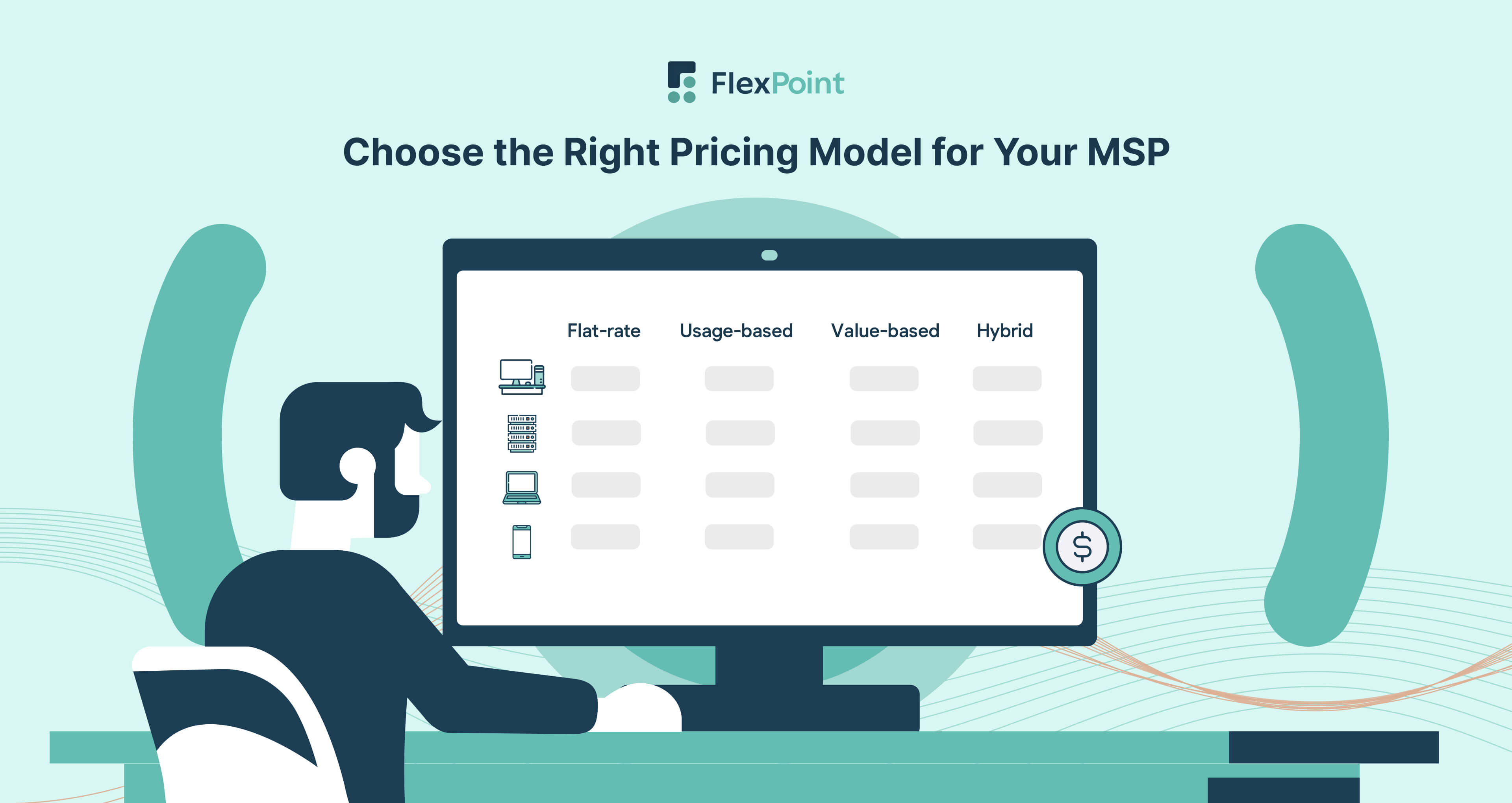
Choosing the right pricing model is a strategic decision for your MSP’s success. Pricing has the greatest impact on your revenue, even more than client acquisition or retention. Yet many MSPs still treat it as an afterthought.
Among B2B leaders surveyed for an SBI report, 94% now update their pricing and packaging at least once a year, and nearly 40% adjust quarterly. However, over a third of B2B companies also reported that they are only adjusting pricing packages without changing price points.
This suggests many pricing teams remain cautious, concerned that price changes might hurt demand or upset loyal clients. For MSPs, this hesitation can lead to missed revenue opportunities and misaligned service expectations.
To stay ahead, MSPs need a pricing model that supports profitability, client trust, and operational clarity.
Subscription and usage-based models are increasingly favored, especially those tied to recurring value.
Value-based pricing is also gaining ground, particularly among growth-stage businesses, because it reflects the measurable impact delivered. For MSPs that can tie outcomes to uptime, cybersecurity, or compliance, this model offers a clear way to communicate value and build stronger client relationships.
Selecting the right model can lead to both financial stability and stronger client relationships.
There isn’t one right answer for every MSP. Some thrive on flat monthly fees, while others prefer per-user or usage-based billing. Your ideal model will depend on your service offerings and the needs of your client base.
In this article, we will examine the most common MSP pricing models and discuss why selecting the right one is crucial. We will also cover how to evaluate which model best fits your MSP business.
After reading, you’ll understand how to align your pricing strategy with your goals and how MSP-specific billing automation software supports all these models with automation and real-time insights.
{{toc}}
The Importance of Selecting the Right MSP Pricing Model
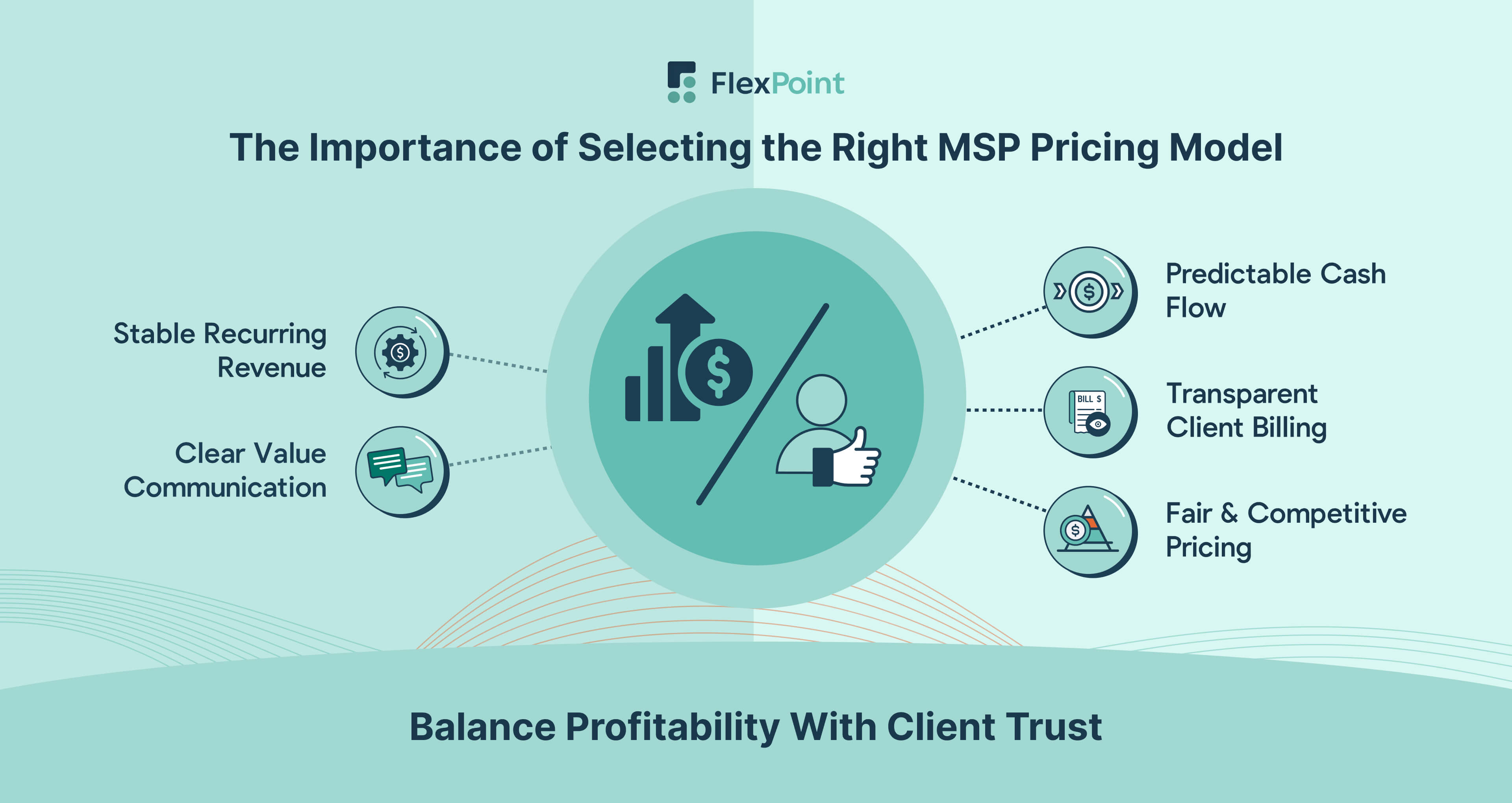
Selecting the right pricing model is essential for maintaining healthy profit margins and ensuring client satisfaction. It directly impacts your cash flow and how clients perceive your services.
A well-suited model provides stable recurring revenue, making it easier to plan and invest in growth. Conversely, a poorly chosen model can leave money on the table or cause billing frustrations.
For example, a break-fix approach can lead to unpredictable revenue swings, whereas a monthly recurring model delivers consistency.
MSPs that underprice (or underbill) their services risk becoming unprofitable, while overpricing (or overbilling) can drive clients away to competitors. You need to find a “sweet spot” where your prices reflect the value you deliver without shocking your clients.
This is why your pricing model matters: it must be profitable for your business and fair for your clients.
The right model also enhances transparency and trust. If your billing is unpredictable or confusing, clients may lose confidence in your services. In fact, according to data from Versapay, 82% of companies lose clients due to poor billing communication.
Choosing a pricing structure that aligns with client expectations and communicating it clearly helps build loyalty and reduce disputes.
Ultimately, the right pricing model sets the foundation for long-term client relationships and steady business growth.
{{ebook-cta}}
11 Common MSP Pricing Models
MSPs typically choose from a range of pricing strategies to package their services for clients.
Below are ten of the most common MSP pricing models, along with their pros, cons, and the types of businesses they best suit.
1. Per-Device Pricing
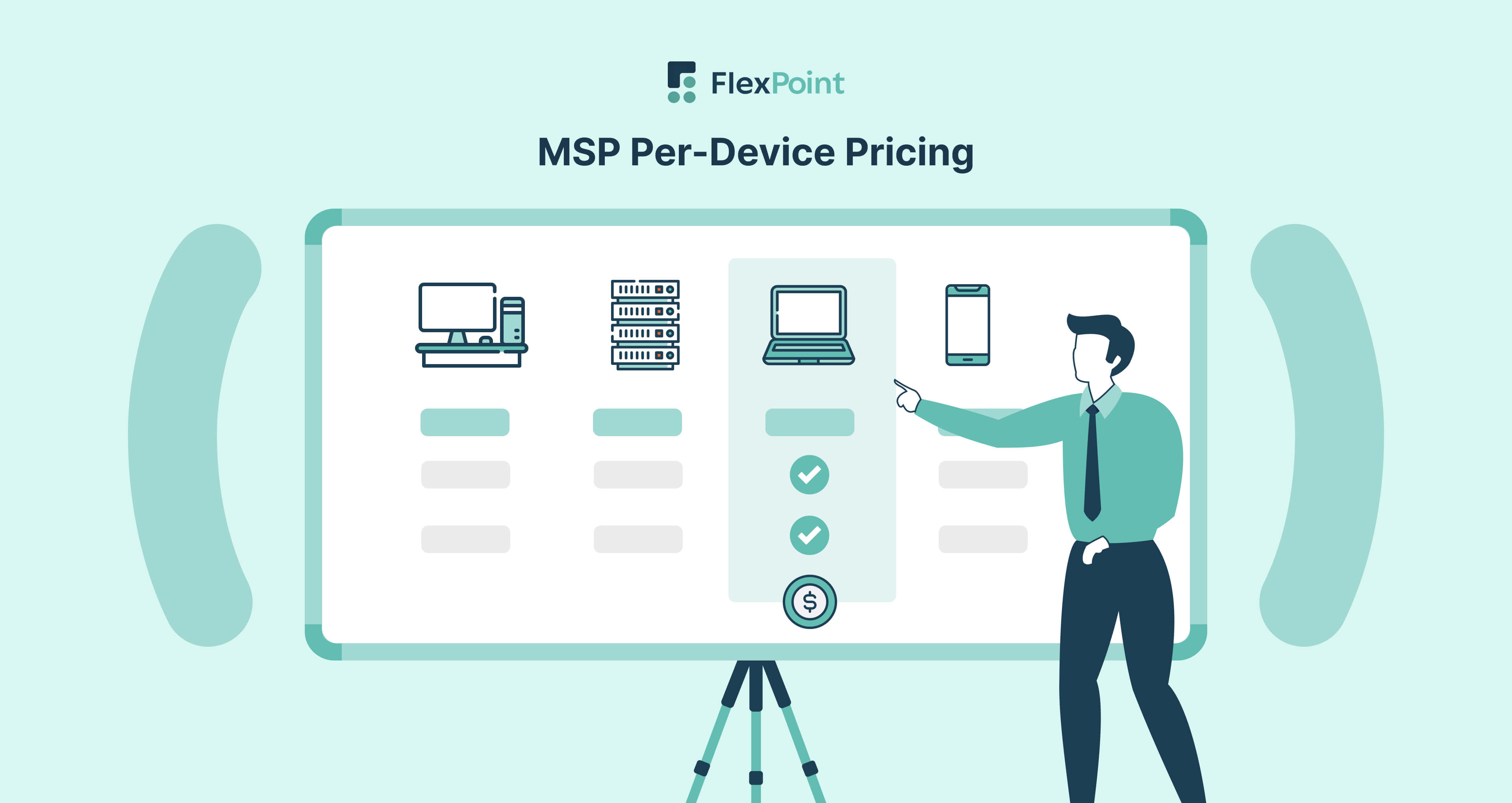
This model charges clients a fixed monthly rate for each device the MSP manages (e.g., per server, per workstation, per mobile device).
- Pros: Per-device pricing scales with the client’s growth, ensuring MSP revenue reflects the amount of equipment supported. It’s easy for clients to understand and budget for by counting devices.
- Cons: The bill can fluctuate whenever devices are added or removed, so the MSP must closely track device counts. It can also become complicated if different device types are priced differently (for example, servers vs. PCs).
- Best for: Organizations with varying device counts per employee or those with bring-your-own-device (BYOD) policies, as it charges exactly for what’s being supported.
2. Per-User Pricing
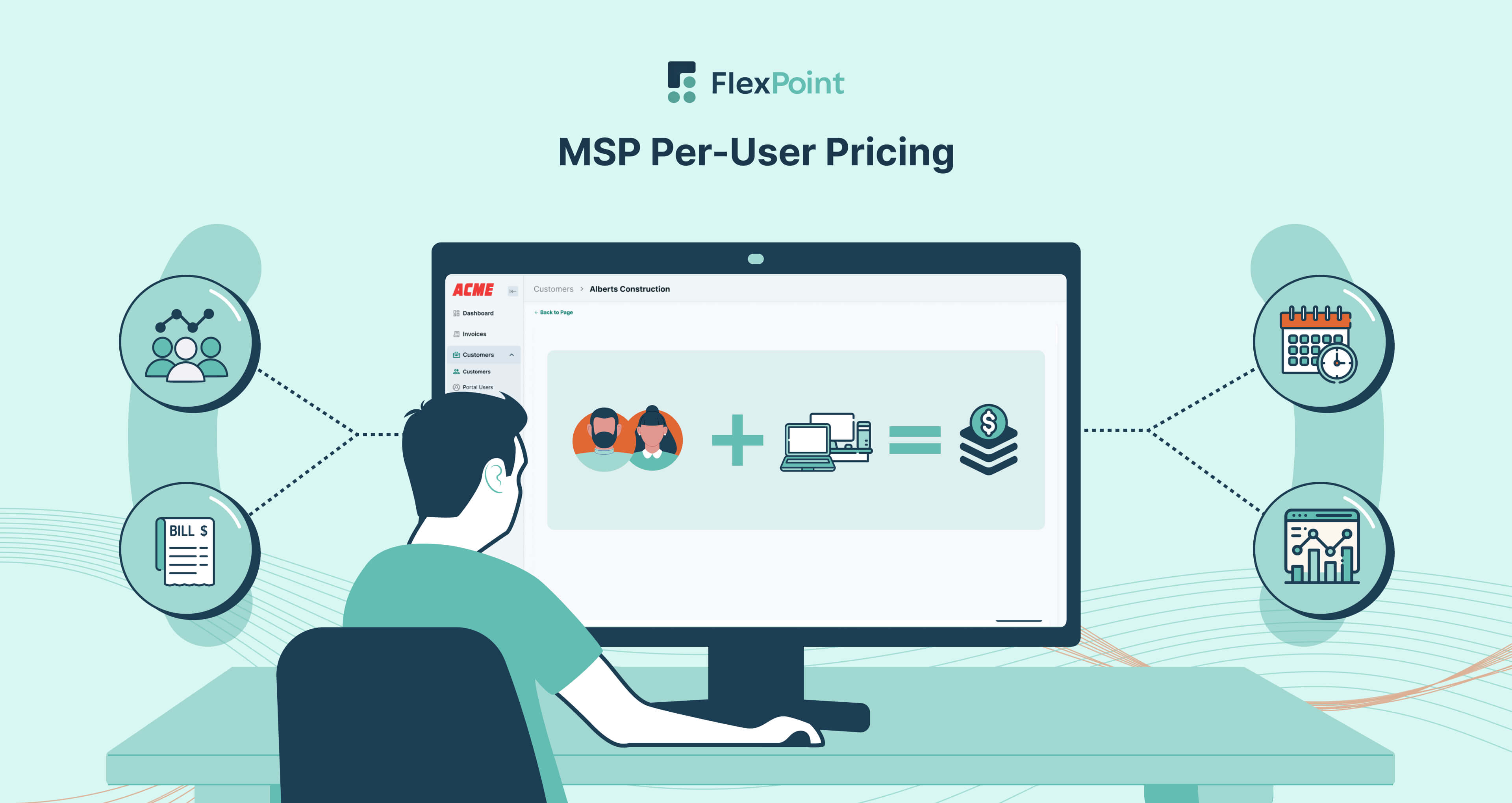
In a per-user model, you charge a flat fee per end-user per month, covering all of that user’s devices and support needs.
- Pros: It offers predictable costs for clients – their bill only changes when their headcount changes. This simplicity makes budgeting easy and shifts the focus away from device counts.
- Cons: An MSP might undercharge heavy-use clients if one user has many devices or high support demands compared to others. Conversely, a light-use client pays the same as a heavy-use one, which can be a point of contention.
- Best for: Companies where each employee uses a standard set of devices, resulting in fairly uniform per-user costs for all users.
3. Tiered Pricing (Bundled Services)
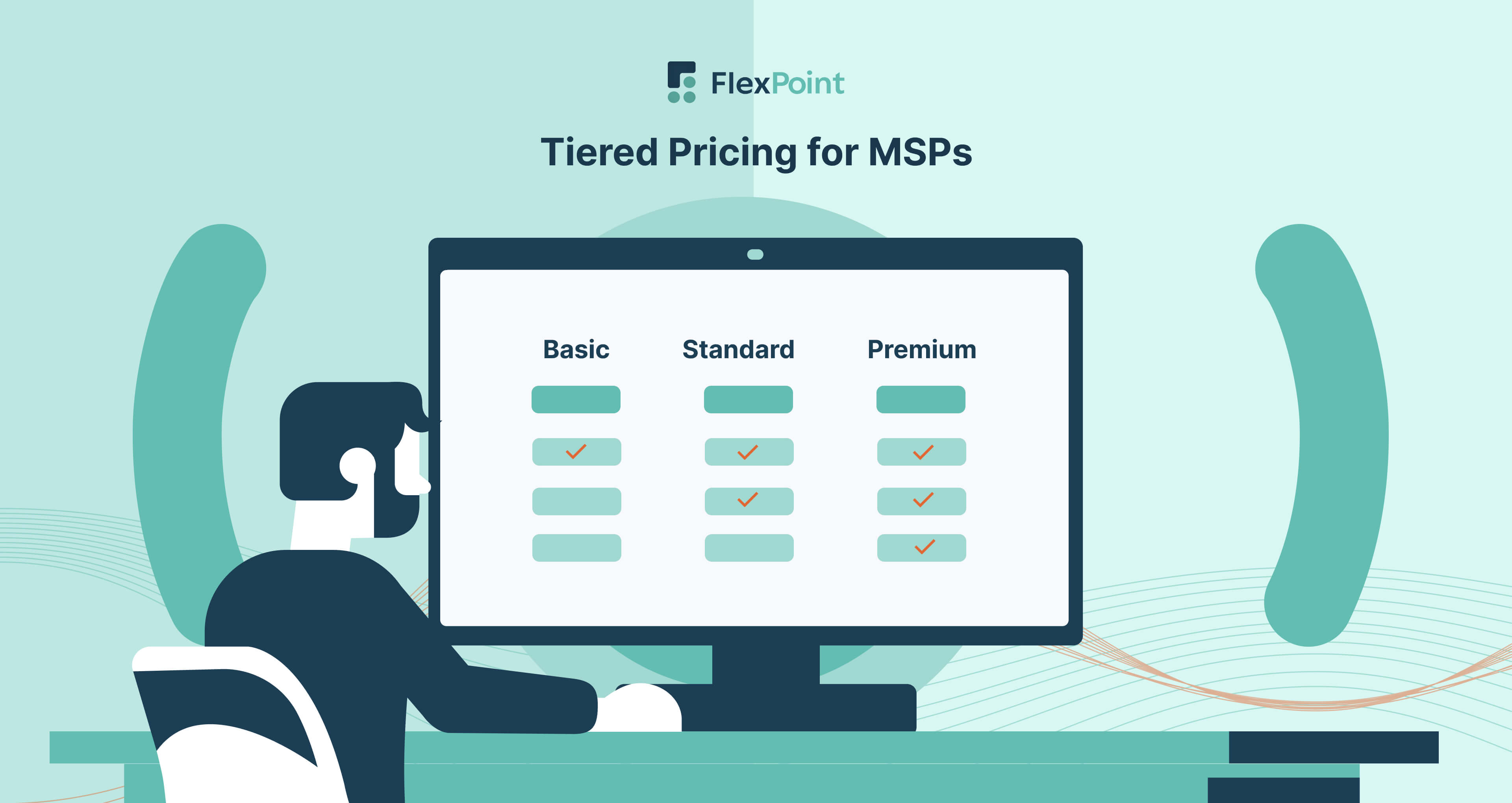
Tiered pricing offers bundled service packages at different levels (often labeled Bronze, Silver, Gold, etc.). Each tier includes a set of services, with higher tiers providing more comprehensive support for a higher fee.
- Pros: It gives clients a choice and makes it easier to upsell. Often, the mid-tier is positioned as the best value. It also streamlines sales by offering predefined options instead of custom quotes for every client. This structure helps MSPs scale more efficiently by reducing the time spent tailoring individual proposals.
- Cons: Clients may opt for a lower-cost tier that doesn’t fully meet their needs, resulting in gaps in service quality. When that happens, clients may become frustrated with limitations they didn’t anticipate, even if they knowingly choose a more basic plan.
- Best for: MSPs serving a mix of small and large clients. Tiered plans allow a small business to choose a basic package, while larger clients can opt for a premium level of service.
4. A La Carte Pricing
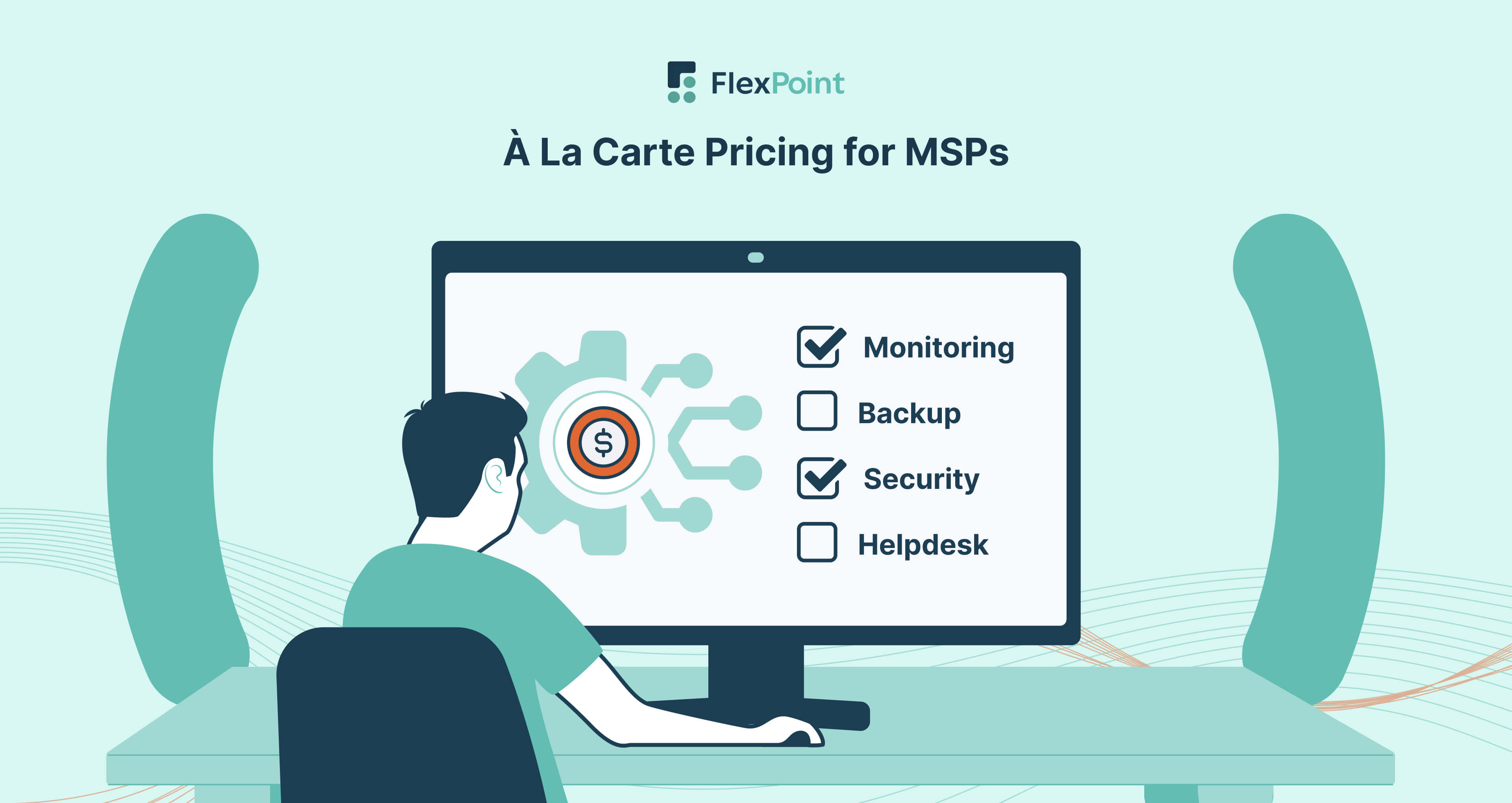
Clients select and choose specific services from a menu (hence the name à la carte), rather than signing up for a preset bundle, allowing them to create a highly customized support plan. This could include selecting just a few core services while excluding others they already manage internally or don’t currently need.
- Pros: Maximum flexibility—clients pay only for the services they want or need. It can help close deals with clients who have very specific requirements or tight budgets.
- Cons: It’s the least standardized model. Every client may have a different mix of services, which can complicate support and billing. Clients may also decline critical (but seemingly optional) services to cut costs, which can lead to potential issues down the line.
- Best for: Niche or small clients whose needs don’t fit neatly into predefined packages. However, many MSPs avoid pure a la carte because it can reduce profitability if clients pick only low-margin services.
5. Flat-Rate (All-Inclusive) Pricing
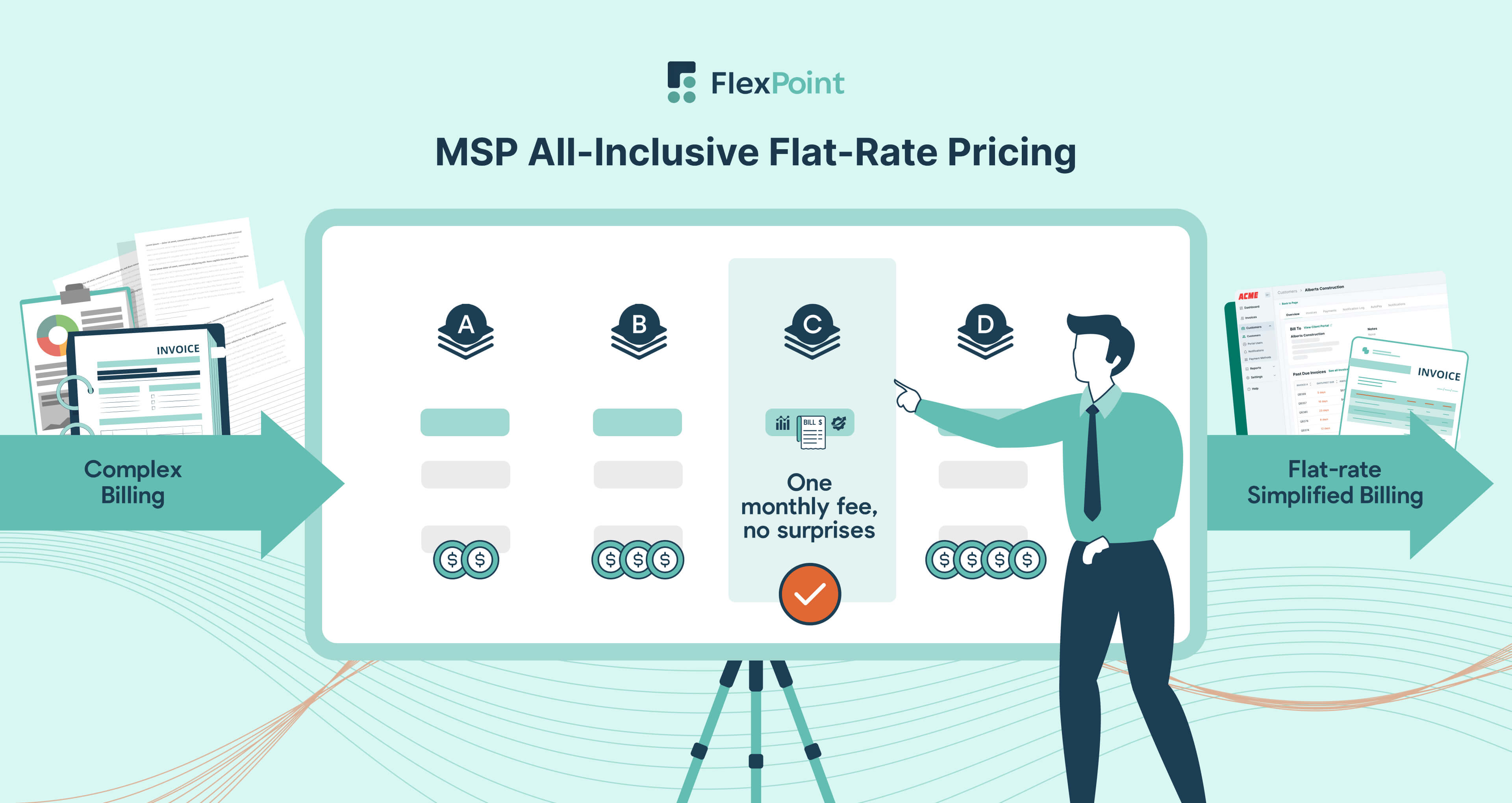
A fixed monthly fee covers all services included in the MSP’s service level agreement, regardless of the amount of support the client utilizes.
- Pros: Clients appreciate the simplicity of paying the same amount each month, without worrying about the number of tickets they’ve submitted or the time the MSP spends on their account. For the MSP, recurring revenue is easier to forecast and manage, and there’s a strong incentive to work proactively.
- Cons: If all-inclusive pricing isn’t carefully calculated, high-touch clients can quickly consume more time and resources than expected. Flat-rate contracts shift more risk to the MSP, so they must have clear boundaries in place to prevent scope creep. Profitability depends on efficient tools, strong processes, and a good understanding of the average cost per client.
- Best for: MSPs with established systems, automation in place, and a solid grasp of their service delivery costs. This model is well-suited for clients who require comprehensive support and a predictable monthly budget, particularly in industries where IT disruptions are costly.
6. Monitoring-Only Pricing
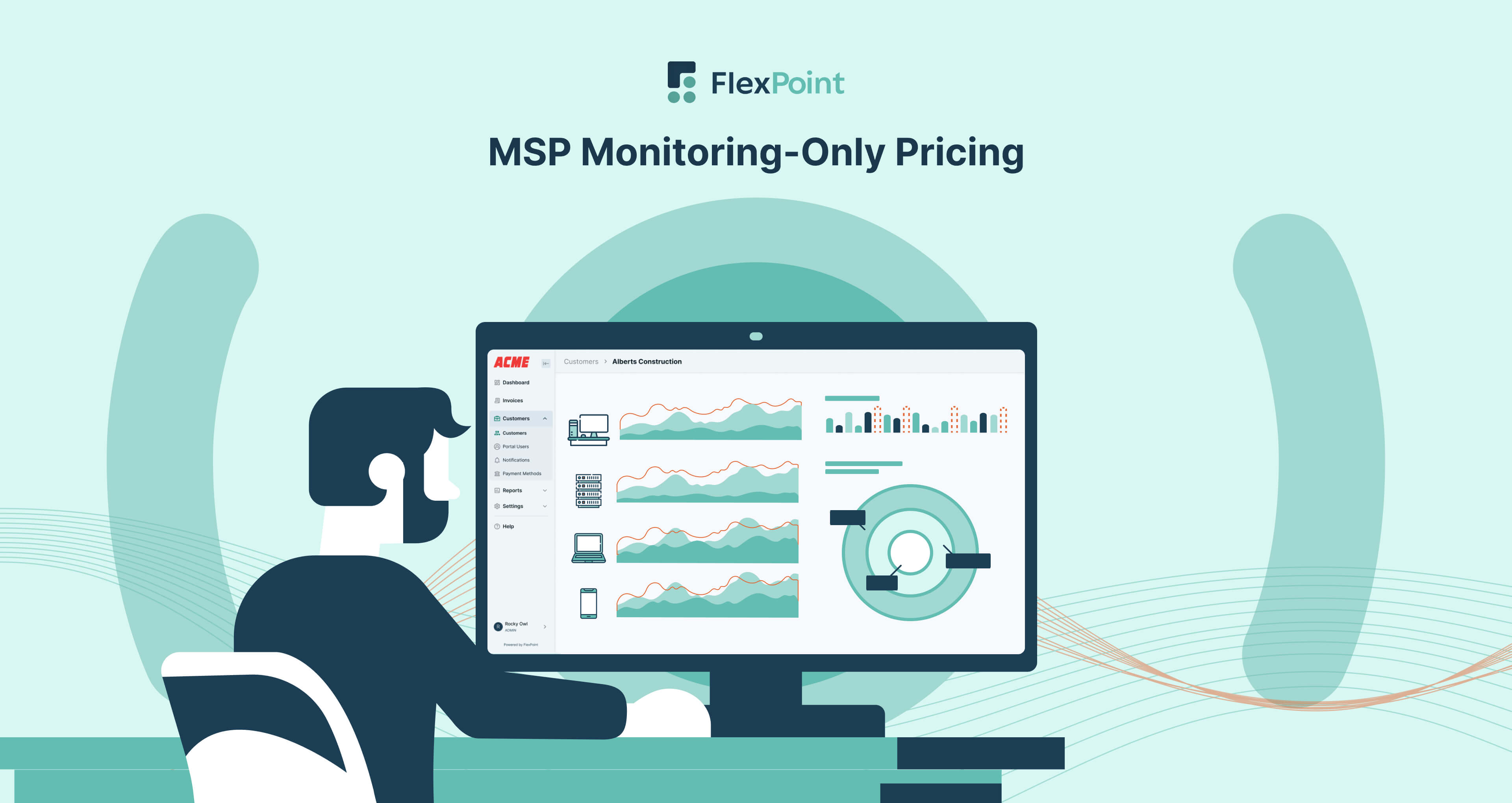
Clients pay a low monthly fee for system monitoring and real-time alerts, but any hands-on remediation, troubleshooting, or issue resolution is billed separately when needed.
- Pros: It’s a low-commitment option that still brings in consistent recurring revenue. MSPs can automate much of the monitoring with remote management tools, reducing the need for hands-on support. This model also serves as a useful entry point for prospects who aren’t ready for full-service contracts.
- Cons: Clients may assume the MSP will handle all detected issues automatically and feel blindsided when asked to pay extra for remediation. This can lead to confusion or dissatisfaction if the scope isn’t clearly defined from the start. The lower monthly fee may also limit profitability unless remediation work is frequent and well-priced.
- Best for: Businesses with internal IT staff who want external oversight and alerting, or small clients testing managed services without committing to full support. Many MSPs offer monitoring-only as their lowest service tier or as part of a broader upsell strategy.
7. Value-Based Pricing
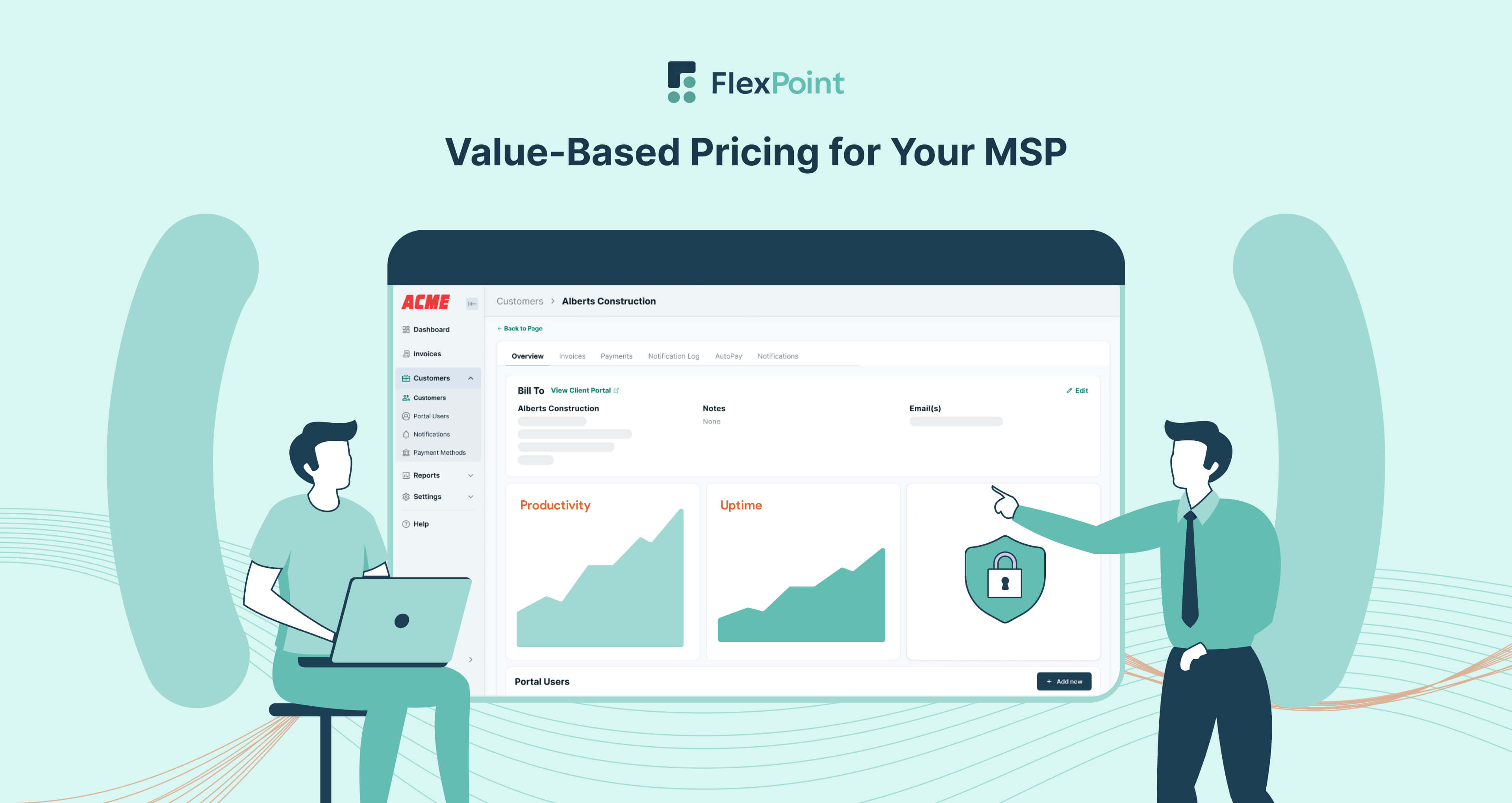
Value-based pricing means setting fees based on the business value or outcomes delivered to the client, rather than on specific services or the number of devices. It typically involves a customized flat fee that covers all necessary expenses to keep the client’s IT running smoothly.
- Pros: This model can be highly lucrative and simple from a billing perspective because one fee covers everything. It keeps the focus on results (uptime, productivity gains, etc.) rather than itemized services.
- Cons: It can be challenging to calculate and justify the “right” price, as value is often subjective. The MSP must clearly demonstrate results to keep clients satisfied, and pricing mistakes can harm both profitability and client trust. It can also be somewhat difficult to implement.
- Best for: Organizations that want the MSP to handle all of their IT operations with an emphasis on performance and business outcomes. It works best when there is a high level of trust and understanding between the MSP and the client.
8. Hourly/Break-Fix Pricing
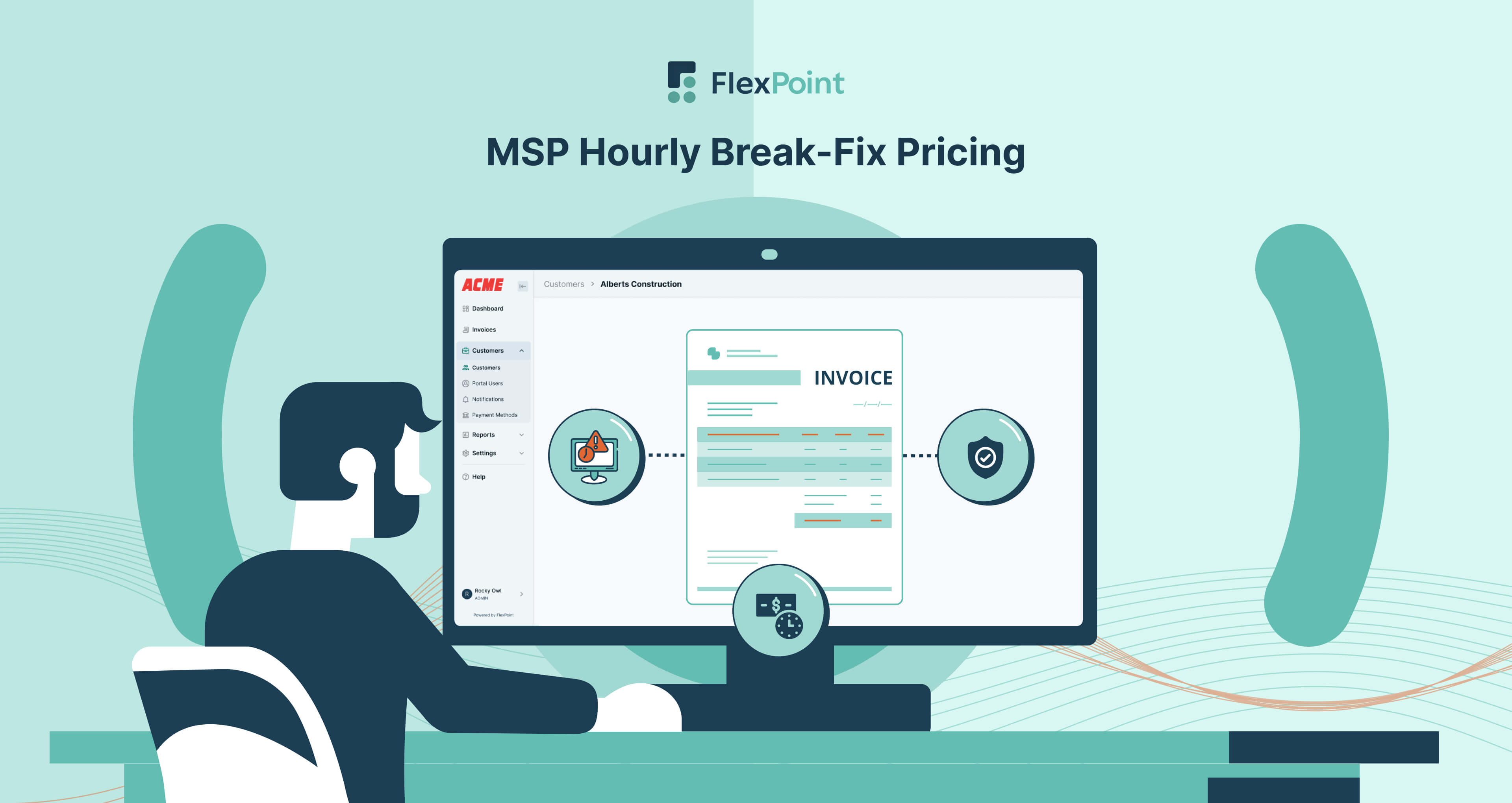
Break-fix is the traditional pay-as-you-go model: the client pays only when they need support, typically billed per hour or per incident. There are no recurring fees or proactive services under this model.
- Pros: For clients, break-fix pricing can seem cost-effective because there’s no recurring fee when systems are running smoothly. For MSPs, it allows the flexibility to set premium rates for emergency or after-hours work. There’s no long-term commitment required, making it easier to take on short-term or ad hoc clients without onboarding them into full managed service agreements.
- Cons: The MSP's income is inconsistent and difficult to forecast. This unpredictability makes it difficult to hire staff, invest in tools, or build a long-term growth plan. Since there’s no proactive monitoring or maintenance, issues often go undetected until they become urgent, leading to larger problems and dissatisfied clients who may blame the MSP despite the reactive model.
- Best for: Very small businesses that require occasional support or one-time projects where long-term service isn’t necessary. Break-fix can also work as a transitional model for newer MSPs or those testing a relationship with a potential client.
9. Project-Based Pricing

Project-based pricing assigns a fixed fee to clearly defined deliverables, such as migrating a client’s email systems to the cloud, deploying new hardware across offices, implementing compliance frameworks, or conducting one-time security assessments.
- Pros: Fixed pricing simplifies internal approvals and budgeting, especially for businesses with rigid procurement processes. For MSPs, project-based pricing offers an additional revenue stream without disrupting the recurring service model. It enables your team to monetize their expertise in areas such as cloud architecture, compliance readiness, or infrastructure upgrades.
- Cons: Accurate scoping is critical. If the time or resources required are underestimated—or if the client makes frequent changes mid-project—profit margins can erode quickly.
- Best for: One-time or complex technical initiatives that require planning, execution, and closure. It’s especially valuable for clients with upcoming audits, cloud transitions, or system-wide upgrades who need expert guidance and a firm project timeline.
10. Hybrid Pricing Models
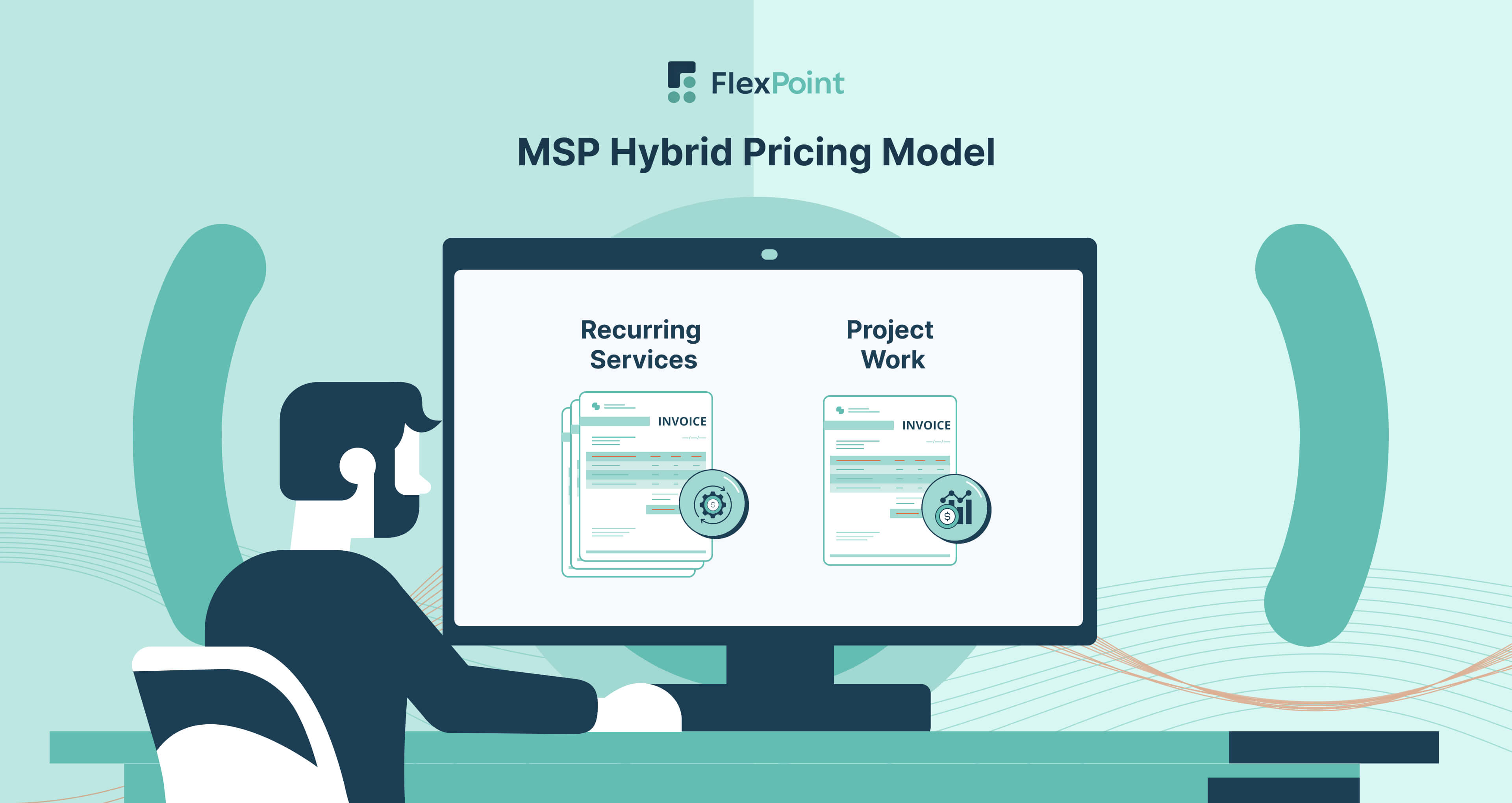
This approach combines elements from multiple pricing strategies. For example, it utilizes per-user billing for day-to-day support, a flat monthly rate for managed backup, and hourly or project-based fees for complex implementations or consulting services.
- Pros: You can provide a predictable monthly fee for core support while charging separately for one-off services that require additional time or resources. It also accommodates clients with different needs or budgets. For the MSP, it opens more revenue channels without compromising consistency.
- Cons: Without the right systems in place, hybrid pricing models can become time-consuming and prone to errors. Tracking which clients are billed under which model, managing exclusions, and issuing separate invoices for different services increases administrative complexity.
- Best for: MSPs with a mature operational setup, varied service catalog, and clients across different industries or sizes. It’s especially effective for MSPs that combine managed services with project-based work or consulting.
11. Usage-Based Pricing Models

In a usage-based model, clients are billed based on actual consumption, such as hours of support used, number of tickets closed, gigabytes of storage consumed, or volume of devices actively reporting. Rather than a flat monthly rate, charges adjust based on measurable usage metrics each billing cycle.
- Pros: This model closely ties pricing to service delivery, which can feel fair and transparent for clients. Businesses with fluctuating needs appreciate paying only for what they use. For the MSP, it allows flexibility to scale services with the client’s activity and introduces opportunities for value-driven upsells. It can also attract new customers who aren’t ready for a full monthly commitment.
- Cons: Usage-based pricing can make revenue unpredictable and more challenging to forecast. If clients suddenly reduce their usage, the MSP’s income drops. It also requires accurate tracking systems to monitor usage in real-time, and billing can become complex without automation. Clients may also be surprised by higher bills during busy periods.
- Best for: MSPs offering cloud services, backup storage, or support models where usage varies month to month. This approach works well for clients with seasonal operations or shifting project workloads.
How to Know Which Pricing Model to Choose?
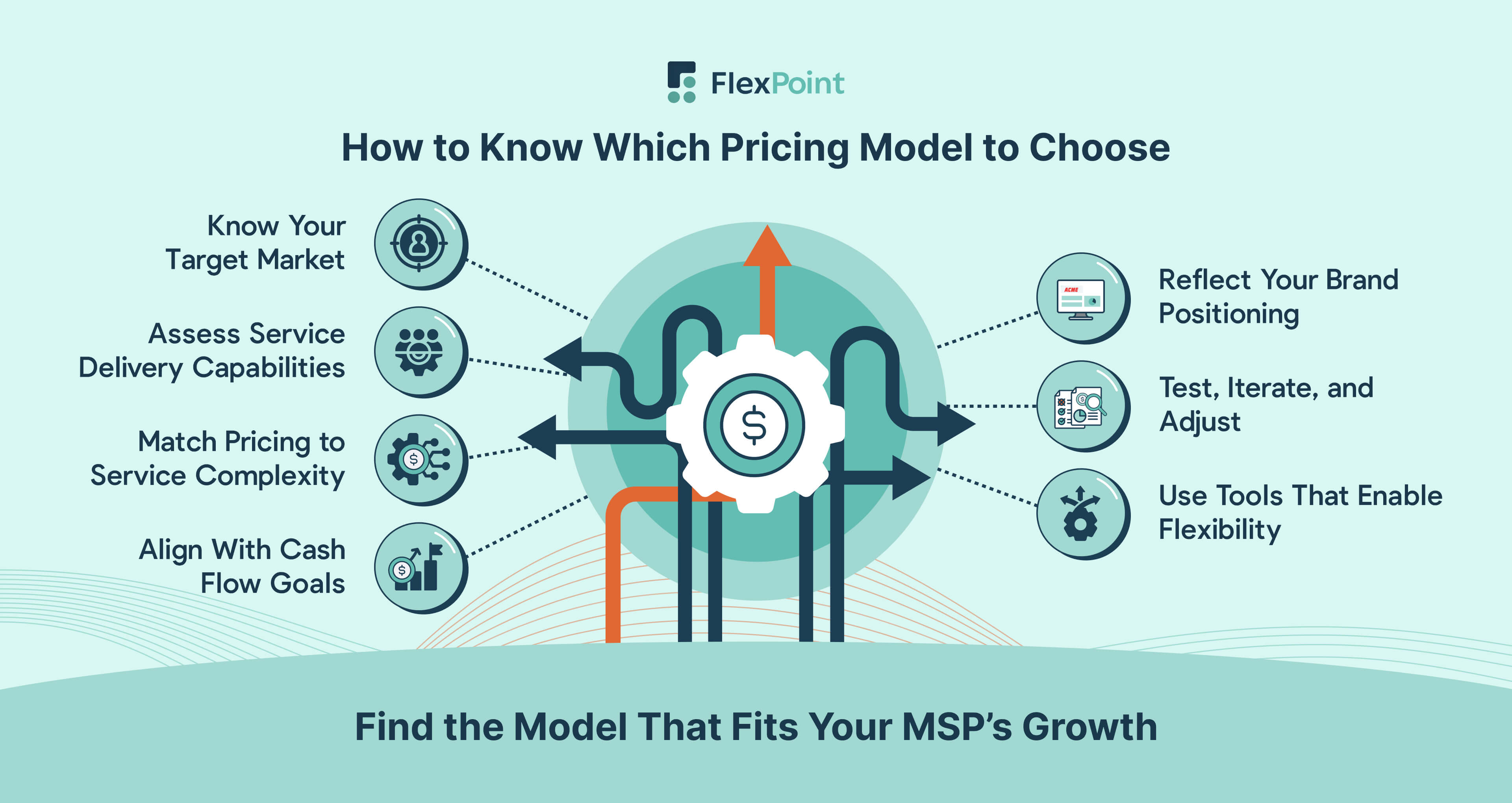
Selecting a pricing model isn’t a one-time decision. Instead, it should be revisited as your MSP grows. There’s no one-size-fits-all answer; the best model depends on your services, clients, and long-term strategy.
For a new MSP, simplicity might be key to attract clients, whereas a more established provider might mix models to maximize revenue.
Below are seven key criteria MSPs should evaluate when selecting a pricing model:
1. Understand Your Target Market
Your pricing model needs to make sense to your clients.
Smaller businesses often prefer simplicity. They want predictable costs and easy-to-understand packages. Flat-rate or per-user pricing usually works well for them. These clients tend to value affordability and transparency, and they may not need the most advanced services.
Larger clients, on the other hand, might expect more flexibility. They may want the option to customize service tiers, add premium support, or purchase services à la carte.
Some enterprise clients are open to value-based pricing if the business outcomes are clear. Consider how tech-savvy your market is, what their internal IT capabilities look like, and how they typically buy services. Align your pricing model with those expectations to reduce friction in the sales process.
2. Assess Your Service Delivery Capabilities
How you deliver services internally should guide which pricing models you can realistically support.
If your operations are streamlined, your tools are integrated, and your processes are well-documented, then you may be ready for all-inclusive or hybrid models. These pricing structures assume you can support multiple clients efficiently while keeping overhead under control.
For newer or smaller MSPs, it’s better to start with models that are easier to manage, such as per-user or hourly billing. These keep scope and invoicing straightforward, helping you avoid underpricing or overservicing.
As your MSP grows and you gain more control over service delivery, you can revisit more complex models that carry higher margins but also require tighter execution.
3. Consider Service Complexity
The broader your service offering, the more strategic your pricing needs to be. MSPs that provide layered services such as help desk, security, compliance, and cloud management often benefit from tiered or hybrid pricing. These models provide you with the flexibility to group services together while still offering upgrade paths for clients who require additional capabilities.
If your services are standardized or narrowly focused, such as RMM and patch management alone, then simpler models, like per-device or monitoring-only pricing, may be more suitable. You won’t need to account for as much variation, and clients won’t be confused by pricing that includes services they don’t need.
Match the complexity of your pricing to the complexity of your offer.
4. Analyze Cash Flow Needs
Recurring revenue is the backbone of most successful MSPs. MSP pricing models, such as flat-rate, per-user, or tiered pricing, generate predictable income. This predictability makes budgeting and growth planning easier. If you’re focused on stability, then these models should be your baseline.
Break-fix or project-based pricing can lead to fluctuations in cash flow. You might get a large payment one month, then go weeks without another. That makes it harder to hire, invest, or cover fixed costs. Even if you offer hourly or project work, consider including a small monthly retainer to keep cash flowing consistently.
Consider your business obligations, including staff salaries, software subscriptions, and taxes, and ensure your pricing model supports the cash flow needed to meet them.
5. Align Pricing with Brand Positioning
Your pricing model is part of your brand. If you present your MSP as a full-service partner, then your pricing should reflect that.
Value-based or flat-rate models often work best in this case because they shift the conversation toward outcomes and outcomes-driven decision-making. These models help reinforce your role as a trusted advisor, not just a vendor.
If your positioning is more about affordability, flexibility, or pay-as-you-go support, then simpler structures like per-device or tiered pricing may be a better fit. Clients will see that you offer modular solutions they can build around their budget.
The key is to ensure that your pricing effectively communicates the type of MSP you are. Consistency between your marketing, service experience, and pricing builds trust.
6. Test and Iterate
No pricing model is perfect from the outset. It’s okay to start with one approach and refine it as you learn what works and what doesn’t. Some MSPs start with per-device pricing, then transition to per-user or tiered structures once they gain a better understanding of their clients.
Collect feedback from your sales team and your clients, and make a note of the answers to these questions:
- Are prospects pushing back on fees?
- Are clients unclear about what’s included?
- Are you consistently over-servicing certain contracts?
Use that insight to adjust. Revisit your pricing structure at least once a year to ensure it remains competitive. Do so more frequently if you’re expanding, changing your services, or targeting a new market.
Refining your pricing strategy over time helps you improve margins, reduce confusion, and stay aligned with both business goals and client needs.
7. Use Tools That Support Pricing Flexibility
Your billing platform plays a crucial role in determining the smooth operation of your pricing model. If you’re offering hybrid pricing, tracking device counts, or billing for both monthly services and one-time projects, you need a system that can handle all of it without added overhead.
FlexPoint supports MSPs at this exact stage.
The platform supports every major MSP pricing model, including flat-rate, per-user, tiered, and custom hybrid structures. You can automate invoices, apply usage-based adjustments, and distinguish between recurring services and ad hoc work.
FlexPoint also integrates with PSA tools (such as ConnectWise, Autotask, SuperOps, HaloPSA) and accounting tools (including QuickBooks Online, QuickBooks Desktop, and Xero), thereby reducing manual entry and billing errors.
Real-time dashboards enable easy tracking of revenue by client, pricing tier, or service type. This provides you with the visibility you need to evaluate profitability and adjust your approach as necessary.
For MSPs looking to scale, the ability to price flexibly and bill accurately is a significant advantage, and FlexPoint is designed specifically to support this need.
Conclusion: Enhancing MSP Profitability with Strategic Pricing Models
Choosing the right MSP pricing model requires understanding your own business needs and your clients’ expectations, and then finding a structure that satisfies both. Fortunately, pricing isn’t set in stone, and you can refine it as you learn what works best for you.
The MSP pricing models discussed in this article, from per-device to value-based, each have their advantages. The most important thing is to be intentional with your choice. Set a pricing strategy that aligns with the value you provide and the costs you incur.
A well-chosen pricing model brings predictable revenue for your MSP and transparency for your clients. It builds trust because clients feel they are getting fair value, and it keeps your business healthy with sustainable margins.
In contrast, a poorly fitting model can lead to frustration, lost sales, or eroded profits. That’s why periodic re-evaluation is so crucial. The market changes, and your pricing should adapt accordingly.
The right billing tools can be a powerful asset in executing your pricing strategy. FlexPoint’s MSP billing platform, for example, supports every MSP pricing model while automating invoicing, tracking usage, and generating real-time financial reports.
What sets FlexPoint apart is how it connects all your billing, service, and payment workflows in one place. It integrates with your PSA, accounting software, and payment processors to eliminate manual entry, reduce errors, and keep everything in sync.
Whether you're managing recurring services, one-time projects, or variable usage, FlexPoint ensures each client is billed accurately and on time.
Having a flexible system in place allows MSPs to adjust pricing models or run multiple models without headaches. Ultimately, the goal is to have a pricing approach that is both profitable for you and beneficial to your clients.
With a solid strategy and the proper support, you set the stage for long-term billing success and happier clients. Done right, it fuels your growth, strengthens client relationships, ensures long-term success, and sets you apart in the competitive MSP market.
Optimize your MSP’s pricing strategy with FlexPoint’s billing automation platform. Implement flexible pricing models, enhance revenue management, and boost client satisfaction today.
Schedule a demo to see how FlexPoint can transform your financial operations regardless of your chosen client pricing models.
{{demo-cta}}
Additional FAQs: MSP Pricing Models
{{faq-section}}










